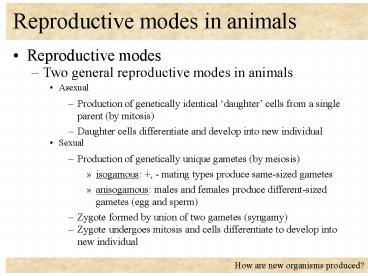Reproductive modes - PowerPoint PPT Presentation
1 / 9
Title:
Reproductive modes
Description:
Budding = asexual reproduction in which outgrowth becomes a new ... Parthenogenesis = development of an egg into new individual without fertilization ... – PowerPoint PPT presentation
Number of Views:115
Avg rating:3.0/5.0
Title: Reproductive modes
1
Reproductive modes in animals
- Reproductive modes
- Two general reproductive modes in animals
- Asexual
- Production of genetically identical daughter
cells from a single parent (by mitosis)
- Daughter cells differentiate and develop into new
individual
- Sexual
- Production of genetically unique gametes (by
meiosis)
- isogamous , - mating types produce same-sized
gametes
- anisogamous males and females produce
different-sized gametes (egg and sperm)
- Zygote formed by union of two gametes (syngamy)
- Zygote undergoes mitosis and cells differentiate
to develop into new individual
How are new organisms produced?
2
Reproductive modes in animals
- Reproductive modes
- Asexual reproduction
- Budding asexual reproduction in which outgrowth
becomes a new
- Common in Phylum Cnidaria (e.g. Hydra)
How are new organisms produced?
3
Reproductive modes in animals
- Asexual reproduction
- Parthenogenesis development of an egg into new
individual without fertilization
- Sonoran spotted whiptail lizard
- unisexual, all-female species that breeds by
parthenogenesis
- ovulation stimulated by "pseudocourtship" among
the females
- unfertilized eggs produce hatchlings genetically
identical to mothers
How are new organisms produced?
4
Reproductive modes in animals
- Asexual reproduction
- Variations of parthenogenesis
- Honeybees
- Queen mates and stores sperm in spermatheca she
controls use of sperm when producing offspring
- males (drones) develop from unfertilized eggs
(parthenogenesis)
- females (workers) develop from fertilized eggs
(sexual reproduction)
How are new organisms produced?
5
Reproductive modes in animals
- Asexual reproduction
- Variations of parthenogenesis
- Daphnia (Water fleas)
- Freshwater crustaceans (Phylum Arthropoda) that
feed on algae
- Cyclical parthenogensis alternate between sexual
reproduction (during periods of stress) and
asexual reproduction
How are new organisms produced?
6
Reproductive modes in animals
- Reproductive modes in animals
- Variation of sexual reproduction
- Simultaneous hermaphroditism single individual
has both male and female reproductive structures
- Tapeworms self-fertilization
- Earthworms during sexual reproduction each worm
acts as male and female
How are new organisms produced?
7
Reproductive modes in animals
- Reproductive modes in animals
- Variation of sexual reproduction
- Sequential hermaphroditism single individual
changes sex during lifetime
- Protogyny change from female to male
- Protoandry change from male to female
How are new organisms produced?
8
Reproductive modes in animals
- Reproductive modes in animals
- Methods of fertilization
- External fertilization fertilization of egg
outside of female body
- Broadcast spawning of marine invertebrates such
as clams
- Many fish and amphibians
- Internal fertilization fertilization of egg
within female body
- Birds, mammals, some fish, reptiles, amphibians
How are new organisms produced?
9
Reproductive modes in animals
- Reproductive modes in animals
- Development modes after fertilization
- Oviparity eggs fertilized internally but
develop outside mothers body
- birds, some reptiles (e.g. turtles), most bony
fish (e.g. sunfish), most insects (e.g.
butterflies)
- Viviparity eggs fertilized internally and
develop internally, relying on nutrition from
females blood
- mammals and many cartilaginous fish (e.g. sharks)
- Ovoviviparity fertilized eggs retained within
mother and develop internally, relying on yolk
for nutrition
- Some bony fish (e.g. guppies), many reptiles
(e.g. garter snakes)
How are new organisms produced?































